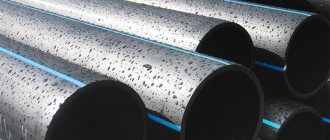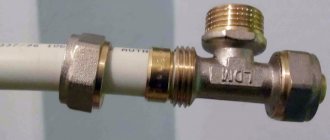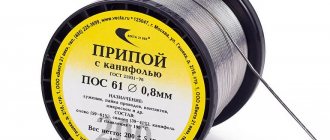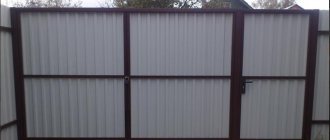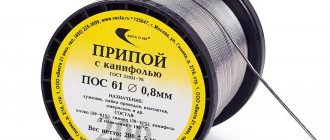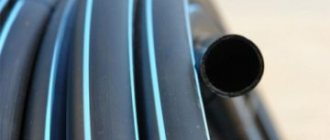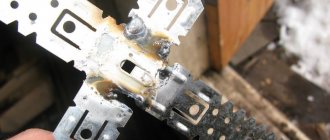How to connect a HDPE pipe to a polypropylene pipe
There are often cases when, while manufacturing a pipeline, one has to face the problem of connecting pipes from different materials. In this article we will look at how to connect a HDPE pipe to a polypropylene pipe.
Types of polypropylene pipe connections
To connect polypropylene pipes with other types of pipes, there are special threaded fittings. One side of the fitting is welded to the polypropylene pipe, and the second side, with threads, is connected to threads of the same diameter on the other pipe. The thread on the fitting can be internal or external. In addition, there are combination couplings. We'll look at them later.
Another type of polypropylene pipe connection is based on a flange connection. This type of connection is used in large-sized pipes. To attach the flange, a sleeve is welded onto the polypropylene pipe, onto which the flange is later placed. Another mounting option is carried out using slip-on flanges. Their device resembles a compression clutch. The flange connection is attached to the edges of a pipe of uniform diameter and tightened with union nuts.
Types of HDPE pipe connections
The HDPE pipe has approximately the same connection devices. The most popular is the collet connection. To connect pipes, a coupling is used, in which there is a collet on one side and a thread on the other. To fasten the coupling, the clamping nut is unscrewed and put on the HDPE pipe. The collet is inserted inside the pipe, the clamping nut is put on and tightened well.
Advice! The clamping nut must not be pressed too hard, otherwise it may burst or the collet will crush the edge of the pipe.
After completing the connection of the collet, it is possible to screw another threaded pipe onto the other edge of the threaded coupling to the same diameter.
The flange connection of HDPE pipes is made similar to the connection outlined above. A sleeve is welded to the edge of the HDPE pipe, onto which the flange is attached. And the same device with a slip-on flange, where the connection is installed on the edges of the pipes and pressed with union nuts.
Connection of two pipes
Using the pipe accessories discussed above, it is possible to easily connect a HDPE pipe to a polypropylene pipe.
- In the first case, you attach a threaded collet to the HDPE pipe, and a combined threaded coupling to the propylene pipe. Wrap FUM tape around the threads to seal and twist them.
- In the second case, you connect two pipes with flanges. Insert a rubber gasket between the flanges to seal and tighten them with bolts.
Combination couplings
While the collet connection for HDPE pipes is clear, the combined couplings (fittings) for polypropylene pipes are varied. Let's take a quick look at them:
- A coupling with an internal thread helps to connect a pipeline with another type of pipe or devices that have an external thread. It consists of a polypropylene blank with an iron coupling pressed inside, on which a thread is cut.
- A male threaded coupling performs the same functions as discussed above. The only difference is that a metal sleeve with external thread is pressed into the polypropylene blank.
- A coupling with a turnkey internal thread is made up of a polypropylene blank into which an iron sleeve is pressed, supporting the edge of the polypropylene with iron edges. The edges are designed for an open-end wrench. The edge is threaded. It is convenient to screw such a bushing onto another thread with a wrench. In addition, there are models of couplings with turnkey edges.
- A coupling with an external thread on a turnkey basis is the same as the coupling outlined in paragraph 3, only it has an external thread.
- A detachable coupling with internal thread is made up of two iron parts under an open-end wrench. Moreover, one iron part is connected to a polypropylene blank. Such couplings are installed in places where it is necessary to disconnect the pipeline or remove devices. Another name for this coupling is American. It unwinds with two keys.
- The detachable coupling with external thread is similar to the previous American type. The only difference is the external thread instead of the internal one.
- The coupling with a union nut is made up of a polypropylene blank into which a fitting with a turnkey union nut is pressed. It is installed in the same way as the American one: in the places of the required pipeline connector.
With such combined couplings, soldered to a polypropylene pipe, it is easy to connect to a HDPE pipe, which has a collet with a similar thread.
Soldering PP fittings
Before connecting two pipes with fittings, they must be secured to the pipe. We discussed the fastening of the collet to the HDPE pipe above. Now let's look at the connection of a polypropylene pipe with a fitting.
Polypropylene fittings are connected to the pipe by soldering with a special soldering iron. The soldering iron with nozzles is placed on a stand and heated to 260°C. The edge of the pipe is cleaned of dirt, chamfered and degreased along with the inside of the coupling. the fitting and the pipe are placed on the heated nozzles at the same time. After heating is completed, the pipe is inserted straight into the fitting without turning and allowed to cool. This completes the soldering process.
After reading this article, you can easily connect a polypropylene pipe with a HDPE pipe. All possible options for the correct connection are presented here. There are enthusiasts who claim on construction forums that these two pipes can be soldered with a coupling at different temperatures. But the whole point is that polypropylene and HDPE are made up of different materials, they have different melting points, so such a seam can burst or essentially melt. If you decide to save money and experiment, you will do so at your own risk.
One example of how to replace a section of a metal pipe with a polypropylene one. Using the same principle, it is possible to connect plastic pipes from different materials:
Photo
In these photos you can see how else it is possible to connect plastic pipes:
Source: https://uchebniksantehnika.ru/truby/kak-soedinit-trubu-pnd-s-polipropilenovoi.html
Types of polypropylene pipe connections
To connect polypropylene pipes with other types of pipes, there are special threaded fittings. One side of the fitting is welded to the polypropylene pipe, and the second side, with threads, is connected to threads of the same diameter on the other pipe. The thread on the fitting can be internal or external. In addition, there are combination couplings. We'll look at them later.
Another type of polypropylene pipe connection is based on a flange connection. This type of connection is used in large-sized pipes. To attach the flange, a sleeve is welded onto the polypropylene pipe, onto which the flange is later placed. Another mounting option is carried out using slip-on flanges. Their device resembles a compression clutch. The flange connection is attached to the edges of a pipe of uniform diameter and tightened with union nuts.
Methods for connecting HDPE pipes
Low-pressure polyethylene pipes are a very common type of cold water pipelines. We will analyze in detail how to properly connect a HDPE pipe and in which cases which technique to use. Inexpensive and practical products can be easily installed with your own hands, but this issue also has its own characteristics.
What are HDPE pipes?
Low-density polyethylene is a plastic that has been known for a long time, but pipes from it began to be produced more than 50 years ago. The abbreviation HDPE (low-density polyethylene) is a designation for the production method of the material and has no bearing on the quality of the material.
Produced in different colors. This is necessary so that the buyer knows their purpose:
- for a domestic pipeline with drinking water - blue products or black with a blue stripe;
- for technical structures - simply black.
The diameter of the pipes can be different, its value varies between 16-1600 mm. On sale:
- in measured sections - 6 or 12 meters;
- in coils (with a diameter of 160 mm).
How to connect a HDPE pipe with a polypropylene, metal pipe
The communication network pipeline is often heterogeneous. It uses steel, polypropylene, combined sections, depending on the requirements - hot and/or cold water supply, heating, sewerage. Operating conditions affect the network material and connections. How to correctly connect different component structures is described below.
Methods for connecting pipes made of different materials
Styrenes have rightfully earned popularity in the production of pipes - HDPE, polyethylene, propylene, cross-linked polymer - they have strength and minimal reactions to external and internal aggression of the environment, no worse than steel, and in some respects they are superior to it. Used for hot and cold water pipes, withstand maximum pressure and tensile strength. There are many ways to connect plastic. These are welding, fittings, compression. Is it possible to use them in tandem with pipes of a different material?
Let's consider each case:
How to connect a HDPE pipe to a polypropylene pipe
To fix dissimilar materials, several methods are offered: fittings with threads - internal, external, combined couplings, flanges.
Details:
- Threaded fittings are fixed to the ends of pipes using a welding method. To do this, the fitting structure is disassembled, then one part is welded to the end of one pipe, and the threaded section to the end of the other. A special welding machine melts the plastic, and the joints are strong and airtight. For permanent sections, fittings with embedded heating elements are used.
- Collet couplings . The design is dismountable and consists of a collet, thread and clamping nut. There are many types of couplings for HDPE pipes. To connect the HDPE pipe and the polypropylene pipe in the same way as a fitting, the coupling is disassembled. Then the collet is inserted into the HDPE pipe and secured with a clamping nut, after which the structure is tightened. Do not overpress the fitting, otherwise the pressure of the collet will crush the edges of the pipe or the clamping nut will burst. Then a polypropylene pipe with a similar diameter is attached to the thread.
- Flanges are used when connecting HDPE pipes with others, when the components of a large-diameter network are risers, sewers, etc. In addition to the flange itself, a sleeve is required to secure it. The connection occurs similarly to a collet coupling - the structure is disassembled into parts and attached to different pipes to already welded bushings. The area is fixed using union nuts.
PVC water pipe connection
Plastic pipes for water supply are popular due to their low cost, easy installation and high strength characteristics. In home plumbing they are used for both cold and hot water - it is important to follow the markings.
There are several methods for connecting such pipes:
- Welding is cold and using a special soldering apparatus. In the first case, the “adhesive” composition is a special mass based on polymer compounds and minerals. It has good adhesion, connections with it are tight. Suitable for sections of the network where water flows by gravity - without pressure or pressure. It is simple to use - the pipes are connected, and the mass is applied to the seam.
- Hot welding involves joining at the molecular level. A special soldering machine with holes for inserting the ends of the pipes is used. Before joining, remove the top layer from the edges with a milling knife. The edges of the pipes are melted in the nozzles - the time is strictly regulated - and pressed against each other. Why is the tightness high? Both methods are used both on permanent connections and in tandem with fittings.
- Carving . It is mainly used for connecting PVC water pipes and metal structures. The fitting options are different and allow you to make any transitions - from small to large diameters, turns, inclusion of several pipeline branches in the network. Typically, American couplings, collapsible couplings, and flanges are used for such connections. The connection methods are similar to those described above - the structures are disassembled, placed on the ends of the pipes, and then connected.
- Compression couplings . The pressure method has been successfully used on PVC pipe connections. The design of the fittings allows the edges to be compressed, creating a sealed area. The work does not require temperature conditions or special devices, except for a crimp wrench. It is necessary to disassemble the structure and strengthen the component parts with a ferrule with a seal.
If the network is dismantled, the fittings remain suitable for further use. Preparation for the connection is thorough - the ends of the pipes are cleaned and degreased, otherwise the tightness will remain in question. You cannot pinch the connections so as not to break the ends of the pipes.
Connecting PVC pipes is a simple installation that is accessible to home craftsmen without prior work experience - it is important to choose the right tool and choose the fixing method.
Thus, there are no difficulties in assembling dissimilar pipes. The principle for polymer and metal raw materials is the same. A high-quality connection depends not only on the pipe material or its diameter, but also on the chosen method and correctly selected fittings. Then home communications - plumbing, heating or sewerage - will last a long time.
How to properly connect HDPE pipes with PVC or metal without welding
Pipes made of low-pressure polyethylene (HDPE) outperform metal ones due to their low cost and easy installation.
If you know the technology of pipeline assembly, any home craftsman, even those without practical experience, can handle the job.
Bulky welding machines and other specialized equipment are not required.
articles:
There are 2 ways to connect HDPE pipes:
The first means butt welding with a special soldering iron or electric couplings.
Under the second - fixation with fasteners (couplings for connecting HDPE pipes).
Installation of pipelines from HDPE using the hot method implies a permanent connection with a cold - collapsible one.
One-piece type of connection, more often used when laying pipelines for passing liquids under pressure.
When assembling household pipelines, a detachable connection is used.
Cold installation
This type of assembly is practiced when laying sewer pipelines, the contents of which move by gravity.
In this case, special fasteners are used - fittings, also known as couplings.
They are 2 or more plastic tips connected together that fit onto the ends of the pipes.
According to the method of fastening, fittings vary, but for HDPE pipes, the so-called ones are most often used. compression or crimp.
Do you know about the best bimetallic heating radiators for an apartment? Read this useful article on how to determine the quality of batteries, calculate their quantity and installation methods.
The best pipes for water supply in a private house are written on this page.
A tight connection is ensured by rubber rings enclosed in the housing. When disassembling it, it is not necessary to change the entire fitting; it is enough to install a new ring.
With compression fittings
- Cutting pipes . The cuts on which the fasteners will be attached must be smooth, without burrs. There should be no cracks or other defects on the surface of the pipe that will be hidden under the fitting body.
- Installing a clamping ring on the pipe (its wide part should “look” towards the tail of the pipeline).
- Connection . The pipe is inserted into the fitting sleeve so that the clamping ring moves all the way.
- Tightening . The clamping nut (in most models of fittings it is blue or white) is first tightened by hand, and then tightened with a special wrench. You cannot put too much pressure on the wrench - the plastic may crack.
The advantages of the fitting connection are:
- wide range of applications (suitable for any non-pressure pipelines - waste (sewage wells - SNiP), drainage, etc.);
- widespread and affordable price . Compression fittings are sold in any hardware store. The price of such fasteners depends on the diameter and operating pressure, but, in general, they cost an order of magnitude cheaper than metal couplings, which are used to install, for example, a corner water heated towel rail made of stainless steel steel (written here);
- ease of installation . To connect fittings to pipes, it is enough to have a wrench for plastic pipes on hand (such a tool is not expensive).
A less common type of cold connection is into a socket using special glue.
It is not suitable for all pipelines, but for certain types of them (the best pipes for heating in a private house are written here), “sharpened” for an adhesive connection.
Such pipes have special sockets on which special glue is applied.
When connecting, copolymerization of the plastic pipes with the adhesive composition is ensured, resulting in a strong, airtight connection.
What do you know about a high-pressure hose for washing? Read this useful article about honeycombs, which ones are best to buy and how they differ.
Types of docking
A popular method of producing modern tubular products is the use of styrene. The materials make it possible to produce durable pipelines that are resistant to aggressive environments.
Plastic water pipe
They are used when installing plumbing with hot and cold water. At the same time, there are several methods for joining plastic pipes.
PP pipelines
Pipeline polypropylene parts are connected to each other using soldering. In this case, the joined elements of the system are heated using special welding equipment. It is usually called soldering iron or iron.
Connection with other types of pipe products is carried out using special combined couplings. They are PP products, on one side of which a metal sleeve with external or internal thread is pressed.
The other end of the fitting looks like a polypropylene pipe. It is this part that is soldered to the PP pipe. The other side of the coupling allows you to make a threaded connection with a pipeline made of a different material or with plumbing fittings.
Fittings set
Manufacturers produce PP combined couplings with turnkey edges. Such fittings are first screwed or twisted into a pipeline made of another material, and then welded with a special soldering iron with a PP pipe.
American pipes are also used for joining dissimilar pipes. These are dismountable connecting elements with a union nut and sealing materials.
They are made only of metal with threads on both ends or have a polypropylene pipe on one side. American women take a drag with minimal effort.
HDPE pipelines
Pipe sections made of low-density polyethylene are connected by creating a weld or fittings. In the second case, the tightness of the joint depends on the quality of the connecting elements and compliance with the installation technology.
Installation of water supply
The weld is created using special equipment. Installation is carried out using an electric coupling or the “butt-to-butt” method. The use of welding implies the creation of a permanent connection.
To ensure that the joint can be disassembled if necessary, special sealed parts are used. These are inexpensive, reusable HDPE fittings. Their design contains a clamping nut, the degree of tightening of which determines the tightness of the connection.
Special fittings are also produced for connecting pipelines made of dissimilar materials. Such elements have a thread at one end, and the other side is a smooth HDPE pipe with a clamping nut.
There are other options for joining pipelines made of different materials. They will be described below.
How to switch from HDPE to polypropylene
Hello dear reader! If you need to lay a cold water pipeline, you can use products made from low-density polyethylene (HDPE), an inexpensive and practical material. Each material has its own subtleties and installation features. In this article we will tell readers how to connect a HDPE pipe.
Scope of application
HDPE is used exclusively for cold water pipelines, as it can be operated at a temperature of no more than 40 °C. Working pressure – no more than 20 MPa (2 atmospheres). They are used everywhere for laying water supply and sewerage networks underground and water supply systems from a well with a pump.
Wider distribution is hampered by instability to ultraviolet radiation - it will not be possible to completely switch to HDPE.
In addition, communication or power supply cables are laid in smooth or corrugated tubes.
Advantages and disadvantages of these pipes:
Advantages
- low cost;
- chemical inertness - does not react with alkalis or acids; the water does not acquire any foreign taste or smell;
- corrosion resistance; resistance to aggressive environments;
- durability - the first pipes have been in service for more than fifty years;
- smooth inner surface - such pipes do not “overgrow” with calcium salts, like metal ones;
- tolerate freezing with water inside and do not burst like metal ones;
- are not afraid of temperature changes (ranging from - 20 ° C to 40 ° C):
- plastic polyethylene easily tolerates soil movements;
- Manufacturability – easy and quick installation;
- polyethylene is environmentally friendly - its production and disposal do not lead to environmental pollution;
- their low weight facilitates their installation, storage, and transportation.
Flaws
- the most significant drawback is sensitivity to ultraviolet radiation. Water pipelines left in the open sun will begin to deteriorate in just a couple of years. Therefore, HDPE water pipes are used exclusively in underground communications and in rooms with artificial lighting or no light at all (for example, in basements and ground floors without windows);
- not intended for use with hot media.
Requirements for welded joints
- there cannot be any depression at the seam site - only a protruding roller;
- the displacement of the ends relative to each other should not exceed 10% of the pipe wall thickness;
- with a wall thickness of up to 5 mm, the thickness of the roller should not be more than 2.5 mm; for wall thickness - no more than 5 mm.
Required tools and materials
- centralizer;
- hydraulic unit;
- heater with temperature control;
- electric trimmer;
- inserts for various diameters of welded products.
Work progress
- HDPE pipes are clamped in a centering device;
- trimming and chamfering is carried out;
- the ends are degreased;
- surfaces are heated by a welding heater and melted;
- the welding heater is removed;
- the ends are compressed so that a seam bead is formed;
- the pipes are not touched until completely cooled, then the centralizer is removed.
What are HDPE pipes?
HDPE is produced by extrusion from polymerized ethylene. Finished products in the form of pipes are used for the construction of highways for the transportation of liquid and gaseous media. This can be natural fuel, drinking or industrial water, wastewater. The classification is also based on the permissible pressure inside the channels. High-pressure ones cope with 2.5 MPa, low-pressure ones with 0.6 MPa, non-pressure ones are designed for the installation of gravity wires.
The basic technical characteristics of HDPE pipes are as follows:
- the operating temperature range is presented as -20-+40 degrees Celsius;
- the maximum thermometer readings are +70 degrees Celsius;
- strength up to 38 MPa;
- pressure ranging from 6 to 25 Atm;
- diameter up to 120, less often up to 150 mm.
In addition to the construction of highways using HDPE products, protection devices for electrical wiring are allowed. The product lasts for about 50 years. On trading floors, pipes are presented in the form of coils of 100, 200 and 1000 m or sections of up to 12 m.
Coils and cut products from HDPE Source billionnews.ru
Advantages and operational features of HDPE pipes
The versatility regarding the use of HDPE pipes is explained by the tightness, elasticity and resistance of the material to aggressive operating conditions. The internal surface of the products is smooth, which virtually eliminates the risk of accumulation of sludge and deposits, ensuring efficient use of the wire throughout its entire service life.
Also, the advantages of such products include the following properties:
- corrosion resistance;
- inertness to the chemical environment;
- lightness (almost 6 times less than steel);
- plasticity (movement without depressurization is allowed by 5-7% of the initial position, which is important in case of freezing of transported liquids);
- resistance to water hammer;
- simplicity regarding installation and maintenance;
- low cost.
HDPE wire for drinking water Source otoplenin.ru
The material is environmentally friendly and allows self-installation. But there are disadvantages that need to be considered before choosing. It is unacceptable to use HDPE pipes for heating equipment. To lay channels in the ground, its mobility must be taken into account. Ultraviolet radiation negatively affects the technical characteristics of the material.
Determination of Applicability
To simplify the selection of low-density polyethylene pipes, manufacturers mark the finished product and apply a color indicator. Thus, a yellow longitudinal stripe indicates the purpose for a gas pipeline, red and blue - for cold and hot water, respectively. Regarding the maximum pressure, the designations PE 63, PE 80 and PE 100 are applied. Underneath this lies 6.3, 8 and 10 MPa.
Marking on finished products Source dpm-system.ru
Another method (also indicated in the labeling) involves tracking the SDR indicator. This is a dimensional coefficient that hides the ratio of the cross-section to the wall thickness. It looks like this (SDR/pressure limit):
- For pressure main systems, gas pipelines and sewers, the following indicators are relevant: 6/25, 7.4/20, 9/16, 11/12.
- Irrigation installations and low-pressure water pipelines: 13.6/10, 17/8, 17.6/7.
- Water supply to low-rise buildings is provided by pipes with SDR 21 and a permissible pressure of 6 Atm.
For internal service of houses with drinking water and gravity sewerage systems, products with a size coefficient of 26, 33 or 41 are used. This corresponds to a pressure of 4 to 5 Atmospheres.
